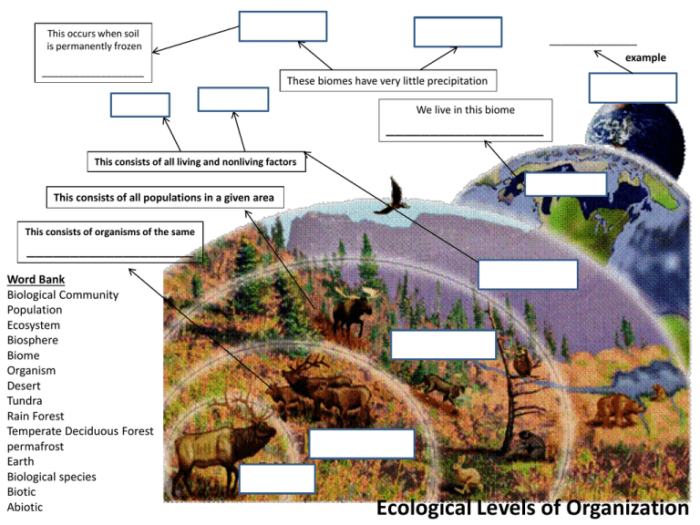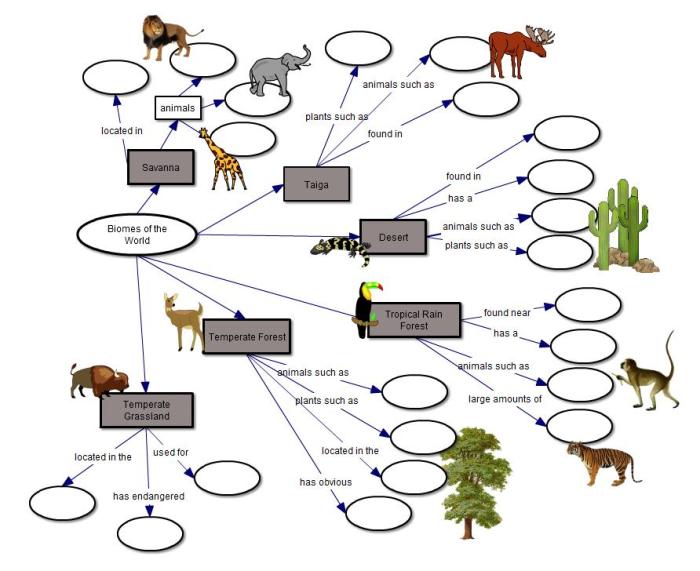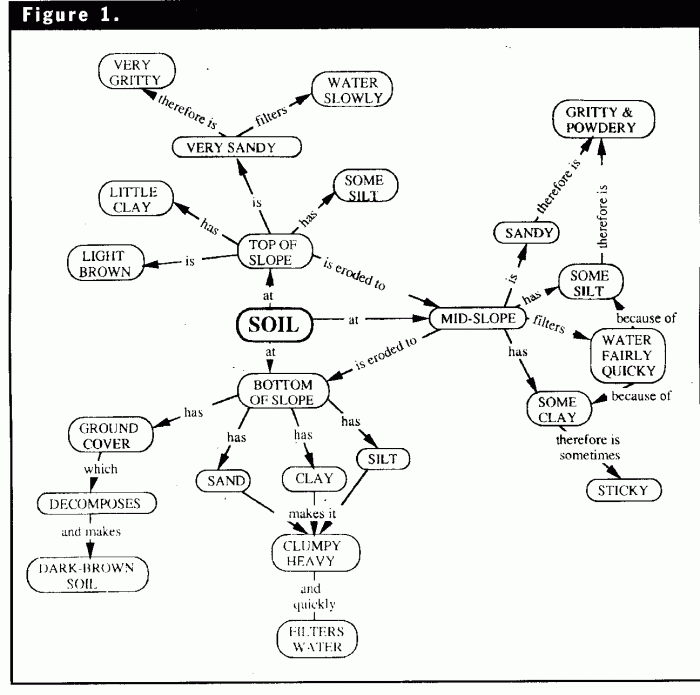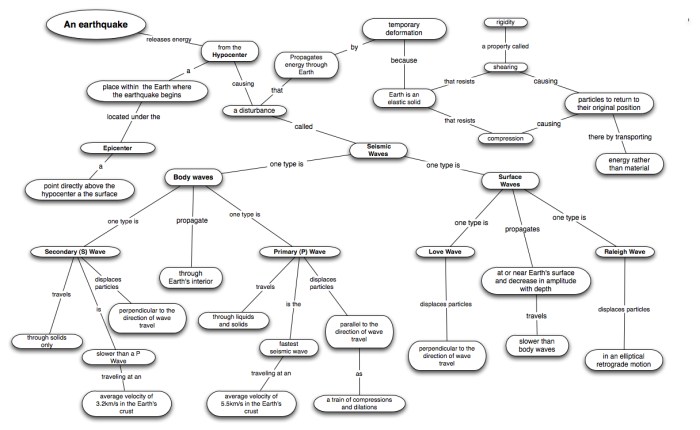Embark on a captivating journey with the biomes concept map answer key, your gateway to understanding the intricate tapestry of Earth’s ecosystems. Delve into the key concepts, explore diverse biomes, and unravel the interconnectedness that shapes our planet.
Uncover the purpose and components of a biomes concept map, gaining insights into the characteristics of different biomes and their fascinating relationships. Discover the practical applications of these maps in environmental science, geography, and education, empowering you to make informed decisions and solve complex problems.
Biomes Concept Map

A biomes concept map is a visual representation of the relationships between different biomes. It can be used to show the distribution of biomes around the world, the factors that influence their distribution, and the interactions between different biomes.
The key components of a biomes concept map include:
- Biomes:The different types of biomes that are represented on the map.
- Factors that influence biome distribution:The factors that determine where each biome is located, such as climate, soil, and topography.
- Interactions between biomes:The ways in which different biomes interact with each other, such as through the exchange of energy and nutrients.
Biomes can be classified into several different types, based on their climate, vegetation, and animal life. Some of the most common biomes include:
- Tropical rainforest:Tropical rainforests are found in warm, humid regions near the equator. They are characterized by tall trees, dense vegetation, and a high level of biodiversity.
- Temperate rainforest:Temperate rainforests are found in cooler, wetter regions than tropical rainforests. They are characterized by tall trees, a dense understory, and a moderate level of biodiversity.
- Temperate deciduous forest:Temperate deciduous forests are found in regions with a moderate climate. They are characterized by trees that lose their leaves in the fall, a diverse understory, and a moderate level of biodiversity.
- Grassland:Grasslands are found in regions with a dry climate. They are characterized by grasses, few trees, and a low level of biodiversity.
- Desert:Deserts are found in regions with a very dry climate. They are characterized by a lack of vegetation, a high level of solar radiation, and a low level of biodiversity.
Biomes are not isolated from each other. They interact with each other in a variety of ways, such as through the exchange of energy and nutrients. For example, tropical rainforests can provide water vapor to temperate rainforests, and temperate rainforests can provide nutrients to grasslands.
Creating a Biomes Concept Map: Biomes Concept Map Answer Key

Crafting a biomes concept map is a fantastic way to visualize and comprehend the intricate relationships between Earth’s diverse biomes. By employing visual aids and symbols, you can effectively represent the unique characteristics, interactions, and distributions of these ecosystems.
Delving into the intricacies of biomes, it’s like listening to a symphony of life. Each biome plays its unique melody, creating a harmonious tapestry. Just as the clarinet’s A-flat major scale brings forth a distinct sound, so too does each biome offer its own set of characteristics.
Returning to our concept map, we can trace the intricate connections between these vibrant ecosystems, unraveling the secrets of their interdependence and resilience.
Gathering Data and Organizing Information
Before embarking on your concept map, gather comprehensive data on various biomes. Consider their geographic locations, climates, dominant plant and animal species, and any notable ecological processes. Once you have this information, organize it into logical categories or themes that will guide the structure of your map.
Analyzing a Biomes Concept Map

A biomes concept map is a visual representation of the relationships between different biomes. It can be used to identify patterns and relationships between different biomes, as well as to understand the factors that influence the distribution of biomes around the world.
To analyze a biomes concept map, start by identifying the different biomes that are represented on the map. Once you have identified the different biomes, you can start to look for patterns and relationships between them. For example, you might notice that certain biomes are always found next to each other, or that certain biomes are only found in certain parts of the world.
You can also use a biomes concept map to analyze the factors that influence the distribution of biomes around the world. For example, you might look at the relationship between climate and biomes, or the relationship between soil type and biomes.
There are a number of different types of analyses that can be performed using a biomes concept map. Some of the most common types of analyses include:
- Pattern analysis:This type of analysis looks for patterns in the distribution of biomes. For example, you might look for patterns in the distribution of biomes based on climate, soil type, or elevation.
- Relationship analysis:This type of analysis looks at the relationships between different biomes. For example, you might look at the relationship between the distribution of forests and the distribution of grasslands.
- Factor analysis:This type of analysis looks at the factors that influence the distribution of biomes. For example, you might look at the relationship between climate and the distribution of biomes.
Biomes concept maps are a valuable tool for understanding the distribution of biomes around the world. They can be used to identify patterns and relationships between different biomes, as well as to understand the factors that influence the distribution of biomes.
However, there are also some limitations to using biomes concept maps. One limitation is that they can be complex and difficult to interpret. Another limitation is that they are only a representation of reality, and they may not always be accurate.
Despite these limitations, biomes concept maps are a valuable tool for understanding the distribution of biomes around the world. They can be used to identify patterns and relationships between different biomes, as well as to understand the factors that influence the distribution of biomes.
Applications of Biomes Concept Maps

Biomes concept maps are versatile tools with practical applications in various fields. They provide a structured and visual representation of complex ecological relationships, enabling users to understand and analyze biomes effectively.
Environmental Science, Biomes concept map answer key
Biomes concept maps play a crucial role in environmental science, aiding researchers and policymakers in comprehending the intricate interactions within different biomes. By visualizing the connections between species, habitats, and environmental factors, scientists can identify threats to biodiversity and develop conservation strategies.
Additionally, concept maps facilitate the study of climate change impacts on biomes, helping scientists predict and mitigate its effects.
Geography
In geography, biomes concept maps serve as valuable teaching and research tools. They help students visualize the distribution of biomes across the globe, understanding the factors influencing their location and characteristics. Moreover, concept maps enable geographers to analyze spatial patterns and identify areas of ecological significance, guiding land-use planning and conservation efforts.
Education
Biomes concept maps are powerful educational tools, engaging students in the exploration of ecological concepts. By creating and interpreting concept maps, students develop critical thinking, problem-solving, and communication skills. Educators can use concept maps to assess student understanding, identify misconceptions, and foster collaborative learning.
FAQ Guide
What is the purpose of a biomes concept map?
A biomes concept map visually represents the key concepts, components, and relationships within different biomes, providing a comprehensive understanding of Earth’s ecosystems.
How can I use a biomes concept map for analysis?
Biomes concept maps enable you to identify patterns, connections, and interdependencies among different biomes, facilitating in-depth analysis of ecological systems.
What are the benefits of using biomes concept maps in education?
Biomes concept maps enhance student engagement, promote visual learning, and foster a deeper understanding of the complex relationships within Earth’s ecosystems.
